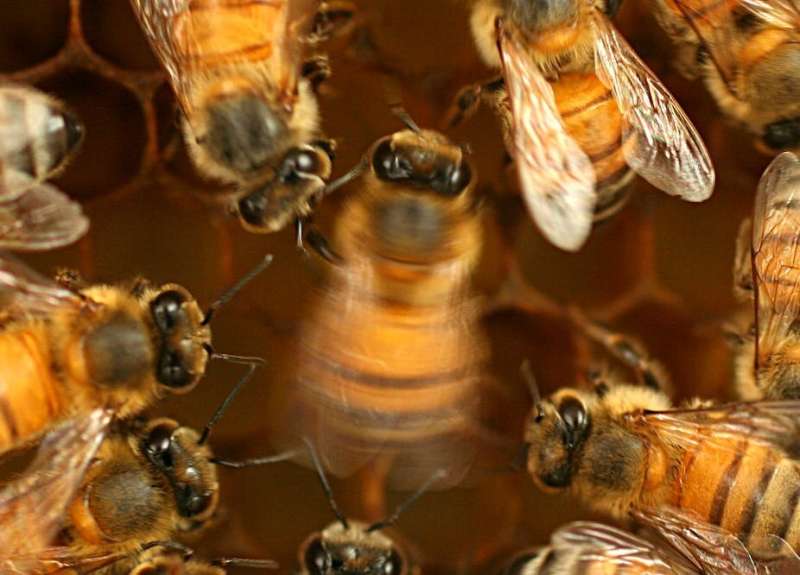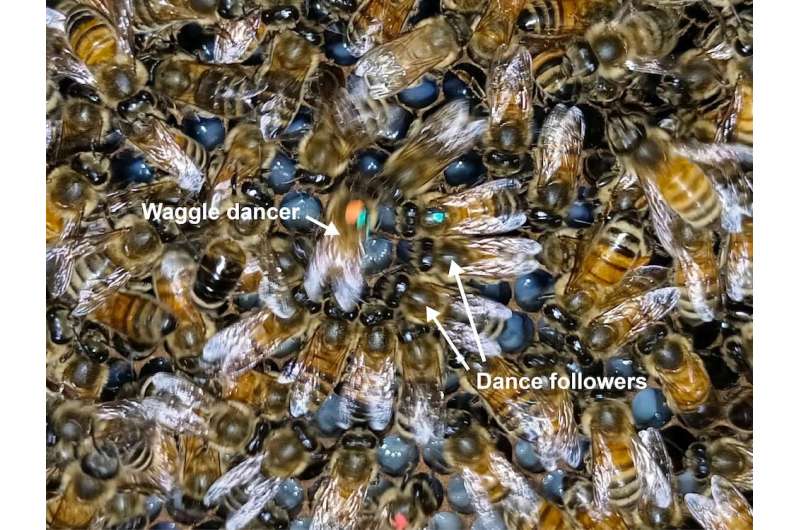Unlocking secrets of the honeybee dance language—bees learn and culturally transmit their communication skills

The Greek historian Herodotus reported over 2,000 years ago on a misguided forbidden experiment in which two children were prevented from hearing human speech so that a king could discover the true, unlearned language of human beings.
Scientists now know that human language requires social learning and interaction with other people, a property shared with multiple animal languages. But why should humans and other animals need to learn a language instead of being born with this knowledge, like many other animal species?
This question fascinates me and my colleagues and is the basis for our recent paper published in the journal Science. As a biologist, I have spent decades studying honeybee communication and how it may have evolved.
There are two common answers to why language should be learned or innate. For one, complex languages can often respond to local conditions as they are learned. A second answer is that complex communication is often difficult to produce even when individuals are born with some knowledge of the correct signals. Given that the ways honeybees communicate are quite elaborate, we decided to study how they learn these behaviors to answer this language question.
What is a waggle dance?
Astonishingly, honeybees possess one of the most complicated examples of nonhuman communication. They can tell each other where to find resources such as food, water, or nest sites with a physical “waggle dance.” This dance conveys the direction, distance and quality of a resource to the bee’s nestmates.
Essentially, the dancer points recruits in the correct direction and tells them how far to go by repeatedly circling around in a figure eight pattern centered around a waggle run, in which the bee waggles its abdomen as it moves forward. Dancers are pursued by potential recruits, bees that closely follow the dancer, to learn where to go to find the communicated resource.
Longer waggle runs communicate greater distances, and the waggle angle communicates direction. For higher-quality resources such as sweeter nectar, dancers repeat the waggle run more times and race back faster after each waggle run.
Making mistakes
This dance is difficult to produce. The dancer is not only running—covering about one body length per second—while trying to maintain the correct waggle angle and duration. It is also usually in total darkness, amid a crowd of jostling bees and on an irregular surface.
Bees therefore can make three different types of mistakes: pointing in the wrong direction, signaling the wrong distance, or making more errors in performing the figure eight dance pattern—what researchers call disorder errors. The first two mistakes make it harder for recruits to find the location being communicated. Disorder error may make it harder for recruits to follow the dancer.

Scientists knew that all bees of the species Apis mellifera begin to forage and dance only as they get older and that they also follow experienced dancers before they first attempt to dance. Could they be learning from practiced teachers?
A ‘forbidden’ bee experiment
My colleagues and I thus created isolated experimental colonies of bees that could not observe other waggle dances before they themselves danced. Like the ancient experiment described by Herodotus, these bees could not observe the dance language because they were all the same age and had no older, experienced bees to follow. In contrast, our control colonies contained bees of all ages, so younger bees could follow the older, experienced dancers.
We recorded the first dances of bees living in colonies with both population age profiles. The bees that could not follow the dances of experienced bees produced dances with significantly more directional, distance and disorder errors than the dances of control novice bees.
We then tested the same bees later, when they were experienced foragers. Bees who had lacked teachers now produced significantly fewer directional and disorder errors, possibly because they had more practice or had learned by eventually following other dancers. The dances of the older control bees from colonies with teachers remained just as good as their first dances.
This finding told us that bees are therefore born with some knowledge of how to dance, but they can learn how to dance even better by following experienced bees. This is the first known example of such complex social learning of communication in insects and is a form of animal culture.
Dance dialects are about distance
A mystery remained with respect to the bees that had lacked dance teachers early on. They could never correct their distance errors. They continued to overshoot, communicating greater distances than normal. So, why is this interesting to scientists? The answer may lie in how distance communication could adapt to local conditions.
There can be significant differences in where food is distributed in different environments. As a result, different honeybee species have evolved different “dance dialects,” described as the relationship between the distance to a food source and the corresponding waggle dance duration.
Interestingly, these dialects vary, even within the same honeybee species. Researchers suspect this variation exists because colonies, even of the same species, can live in very different environments.
If learning language is a way to cope with different environments, then perhaps each colony should have a distance dialect tailored to its locale and passed on from experienced bees to novices. If so, our teacher-deprived individual bees may never have corrected their distance errors because they acquired, on their own, a different distance dialect.
Normally, this dialect would be learned from experienced bees, but could potentially change within a single generation if their environmental conditions changed or if the colony swarmed to a new location.
In addition, each colony has a “dance floor,” or the space where bees dance, with complex terrain that the dancers may learn to better navigate over time or by following in the footsteps of older dancers.
These ideas remain to be tested but provide a foundation for future experiments that will explore cultural transmission between older and younger bees. We believe that this study and future studies will expand our understanding of collective knowledge and language learning in animal societies.
This article is republished from The Conversation under a Creative Commons license. Read the original article.![]()
Citation:
Unlocking secrets of the honeybee dance language—bees learn and culturally transmit their communication skills (2023, March 11)
retrieved 11 March 2023
from https://phys.org/news/2023-03-secrets-honeybee-languagebees-culturally-transmit.html
This document is subject to copyright. Apart from any fair dealing for the purpose of private study or research, no
part may be reproduced without the written permission. The content is provided for information purposes only.
For all the latest Science News Click Here
For the latest news and updates, follow us on Google News.

